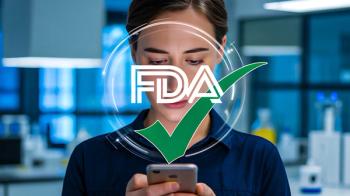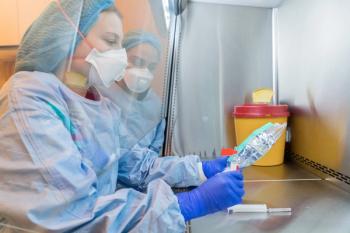
Pharmacy Practice in Focus: Oncology
- December 2020
- Volume 2
- Issue 6
A Collaborative Approach to Specialty Pharmacy at an Academic Medical Center
The SUNY Outpatient Pharmacy has developed a strong collaboration with specialty pharmacy personnel and clinically embedded pharmacists.
The State University of New York (SUNY) Outpatient Pharmacy is a retail pharmacy within Upstate University Hospital (UUH). The outpatient pharmacy is an affiliate of SUNY Upstate Medical University in Syracuse, New York, the only academic medical center in central New York, consisting of 1 hospital, 2 campuses, and 752 inpatient beds with numerous ambulatory sites. The Upstate University Health System serves approximately 1.8 million individuals.
The SUNY Outpatient Pharmacy opened in June 2018. Initially designed for community retail and prescriptions for patients being discharged from UUH— the beds-to-meds program—it has expanded into a fully operating specialty pharmacy with dual specialty pharmacy accreditation from URAC and the Accreditation Commission for Health Care (ACHC). This specialty pharmacy offers patient management for oncology therapies as well as hematology and other therapeutic categories.
Our approach to dispensing and managing patients on specialty medications includes team members working collaboratively with the outpatient pharmacy personnel to provide thorough and efficient care (see Figure 1). Prior authorization (PA) coordinators initiate and complete the PAs for their assigned ambulatory care clinics. Medication assistance coordinators provide financial assistance for any patient with an out-of-pocket cost greater than $25. Between January 2020 and April 2020, more than $200,000 in savings was arranged. Patient care coordinators (PCCs) conduct monthly refill calls for specialty medications. Pharmacists are either embedded in the ambulatory clinics or function from the centralized call center to provide clinical evaluation of patients during therapy. A technology analyst generates reports evaluating patient outcomes.
More than 600 patients are followed monthly through the specialty pharmacy patient management program. Among the total outpatient pharmacy prescriptions filled regularly, 9% consist of specialty medications. More than 7000 specialty medication prescriptions were filled during the 12 months ending September 2020.
Workflow and Practice Description
At our institution, there is a strong collaboration among the specialty pharmacy personnel and the clinically embedded pharmacists. The current work- flow stemmed from a resident-run project implemented in 2019 (see Figure 2). The postgraduate year 2 (PGY-2) ambulatory care pharmacy resident developed a service in the rheumatology clinic with a focus on 4 specialty medications—adalimumab (Humira), etanercept (Enbrel), ixekizumab (Taltz), and belimumab (Benlysta). The rheumatology clinic was one of many ambulatory clinics at our institution that did not yet have a pharmacist presence. The program developed by the resident included navigating investigation of patient benefits, providing patient education for new therapies, monitoring drug-specific laboratory parameters, continuous follow-up of patients, and drug information requests. This program led to an increased capture rate in the rheumatology clinic for the 4 drugs and set the framework for the current workflow for all embedded pharmacists that the specialty pharmacy participates with. Additionally, this pharmacist was hired to maintain these services in the rheumatology clinic after residency completion.
When a prescriber sends a new prescription for a specialty medication to our pharmacy, the investigation of benefits occurs first. The PA coordinator assigned to that clinic will work closely with the embedded clinical pharmacist to gather all necessary information to submit to the insurance company. Because the coordinator has access to the clinical pharmacist and the electronic medical record (EMR), most of the PAs are completed within 24 to 72 hours. Once the medication is approved, the next step is determining out-of-pocket costs for the patient. The medication assistance team works to lower copays through enrollment in copay cards, financial support from our pharmacy, and more. They will work with the patient to ensure all options are investigated before the final cost of the medication is presented to the patient.
The embedded pharmacist then offers the patient the option of a first dose education session. All patients will receive extensive counseling from the clinical pharmacist prior to initiating therapy. Additionally, the pharmacist will ensure that any necessary drug-specific laboratory parameters are completed prior to initiation. Once started, the clinical pharmacist reaches out within 1 week to assess tolerability. This tolerability check catches many potential adherence barriers that the pharmacist can intervene on and involve the provider if needed. Therefore, adherence barriers are addressed earlier in therapy because they previously may have gone unnoticed until the next 6- to 12-month follow-up appointment with the provider.
After the tolerability check, much of the patient’s ongoing care is shifted to the specialty pharmacy personnel. The PCCs located within the centralized call center manage refill calls, which also incorporate adherence checks, medication history, and any other issues the patient may be having. The PCCs will contact the embedded pharmacist or provider in that specific clinic if issues arise. This comprehensive, closed loop system allows for many therapy barriers to be managed in a reasonable timeframe to avoid complications and poor patient outcomes. In addition to monthly outreach from the PCCs, the clinical pharmacists will follow up with the patients on a routine basis for continued laboratory monitoring, assessment of adherence, identifica- tion of adverse effects, routine drug- interaction checks, and much more. This workflow allows for an extremely high level of patient care. Direct access to the EMR and to the providers, via the embedded pharmacists, allows for increased communication, timely prescription turnaround, and patient satisfaction.
Patient Outcomes
The benefits of the workflow described were evident immediately once implemented in the ambulatory care clinics with specialty services. Providers and patients experienced increased clarity about what step in the process they were in when a new medication was initiated. It also became clear that patients were obtaining access to critical medications more seamlessly through collaboration between the embedded clinical pharmacists, PA team, and specialty pharmacy staff. Therefore, strategies to evaluate the benefits of the specialty pharmacy services were created.
Prompt initiation of disease modifying therapy (DMT) in patients with multiple sclerosis is critical in delaying disability progression, reducing relapse rates, and delaying development of new lesions on MRI. Often, there is a delay between when a drug is ordered during an office visit and when the medication is started by the patient. Delays are the result of the need for PA, coordination of financial assistance, determination of which specialty pharmacy the prescription needs to go, enrollment into a specialty pharmacy system, and shipment of the medication to the patient. Complaints from patients and neurology staff indicated that improvements could be made.
The neurology clinical pharmacist at the SUNY Outpatient Pharmacy adopted the described workflow in May 2019, and time to DMT initiation was evaluated. Between November 2018 and April 2019, for patients receiving their DMT from outside specialty pharmacies, the average time to DMT initiation was 36 days (n = 19). The postintervention data analyzed prescriptions sent to our institution’s specialty pharmacy between May 2019 and May 2020. The average time to DMT initiation for patients started on new therapies was 4.6 days (n = 24). Based on this small quality-improvement project, there is a significant improvement in time to initiation of DMT if the institution’s outpatient pharmacy is utilized. The outpatient pharmacy does analyze the time to specialty medication initiation, and the average number of days to fill a specialty medication between October 2019 and April 2020 was 3.6 days (range 2.4-4.2 days). This data was not analyzed inferentially, but our specialty pharmacy workflow aided in timelier DMT initiation.
Other quality metrics are analyzed regularly. Proportion of days covered (PDC) is calculated on an ongoing basis to assess therapy adherence. Between November 2019 and April 2020, the average PDC was 94.1% (range 92%-98%). Patient satisfaction is assessed through surveys mailed to patients at their primary residence. Since November 2019, patient satisfaction with specialty pharmacy services has ranged from 94% to 100%. Additional quality improvement projects are ongoing.
Current barriers to improving care for more patients are insurance limitations and restrictions on which specialty pharmacies a patient can utilize. Efforts are ongoing to obtain contracts with primary insurers for patients to get their specialty medications at our institution’s pharmacy now that we have received dual accreditation. Additionally, several specialty medications are limited distribution drugs accessible only through certain specialty pharmacies. The specialty pharmacy continues its efforts to obtain contracts with these drug companies to have access to more specialty medications and to improve patient care.
As a member of Acentrus Specialty, a network of more than 100 health systems, SUNY is partnering with peer institutions nationwide to share operational best practices, to gain access to limited distribution drugs, and to obtain contracts with insurers.
Conclusions
Since its creation in June 2018, the SUNY Outpatient Pharmacy has progressed from a retail pharmacy primarily serving patients being discharged from the hospital to also providing exceptional care to patients taking specialty medications. Through collaboration between the outpatient pharmacy, specialty team members, and clinical ambulatory care pharmacists, patients can rapidly begin new specialty medications and remain adherent to them throughout therapy. The novel practice of involving clinic-embedded pharmacists in the specialty pharmacy workflow, having a site based in an academic medical center, and shared access to the EMR have all helped develop a patient-centered workflow.
EAMONN MURPHY, PHARMD, BCPS, is the specialty pharmacy program manager for the SUNY Outpatient/ Specialty Pharmacy in Syracuse, New York. He earned his doctorate of pharmacy degree from Northeastern University in Boston, Massachusetts.MEAGHAN MURPHY, PHARMD, BCACP, is the ambulatory care pharmacy manager at SUNY Upstate in Syracuse, New York. She earned her doctorate of pharmacy degree from Virginia Commonwealth University in Richmond, Virginia, and did her postgraduate year-1 residency training at Kaiser Permanente of the Mid-Atlantic States Region.ERIC BALOTIN, RPH, is the director of retail pharmacy services for SUNY Upstate Medical University in Syracuse, New York. He earned his bachelor of science degree from Massachusetts College of Pharmacy in Boston, Massachusetts, and previously served as director of pharmacy for 2 infusion companies while opening 2 physician- based ambulatory infusion centers in the Syracuse area.
Articles in this issue
almost 5 years ago
PARP Inhibitors Gain Utility in Multiple Malignanciesalmost 5 years ago
Utilizing Companion Diagnostics to Drive Clinical Decisionsalmost 5 years ago
Redefining the Management of Anemia in Patients With Canceralmost 5 years ago
Pharmacists’ Roles in Addressing Oncology Biosimilar Challengesalmost 5 years ago
CDK4/6 Inhibitors Are Game Changers in HR+/HER2- Advanced Breast CancerNewsletter
Stay informed on drug updates, treatment guidelines, and pharmacy practice trends—subscribe to Pharmacy Times for weekly clinical insights.

















































































































































































































